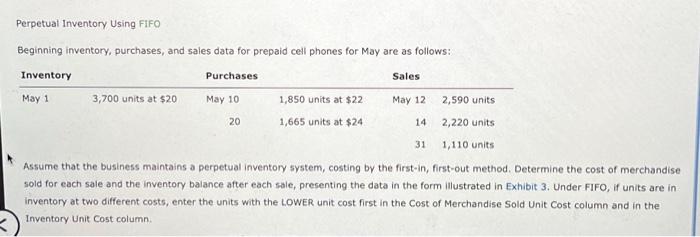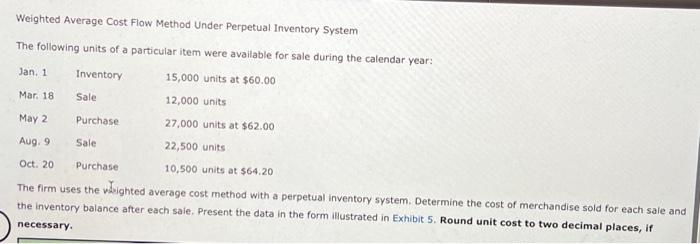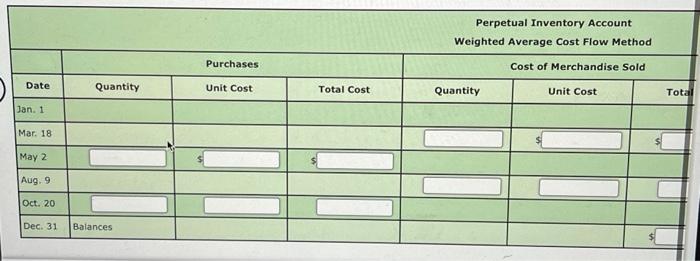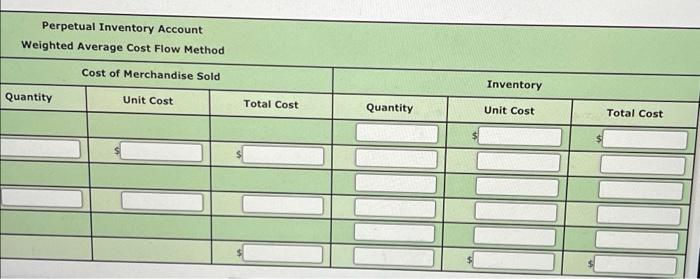Answered step by step
Verified Expert Solution
Question
1 Approved Answer
Perpetual Inventory Using FIFO Beginning inventory, purchases, and sales data for prepaid cell phones for May are as follows: Inventory May 1 Purchases Sales





Perpetual Inventory Using FIFO Beginning inventory, purchases, and sales data for prepaid cell phones for May are as follows: Inventory May 1 Purchases Sales 3,700 units at $20 May 10 1,850 units at $221 May 12 2,590 units 20 1,665 units at $24 14 2,220 units 31 1,110 units Assume that the business maintains a perpetual inventory system, costing by the first-in, first-out method. Determine the cost of merchandise sold for each sale and the inventory balance after each sale, presenting the data in the form illustrated in Exhibit 3. Under FIFO, if units are in inventory at two different costs, enter the units with the LOWER unit cost first in the Cost of Merchandise Sold Unit Cost column and in the Inventory Unit Cost column. Schedule of Cost of Merchandise Sold FIFO Method Prepaid Cell Phones Cost of Cost of Cost of Merchandise Merchandise Merchandise Purchases Purchases Inventory Inventory Sold Quantity Date Purchased Unit Cost Total Cost Quantity Sold Unit Cost Sold Total Cost Inventory Unit Quantity Total Cost Cost May 1 May 10: 1,850 May 12 May 14 May 20 May 31 1,665 May 31 Balances 2,590 8 888 Weighted Average Cost Flow Method Under Perpetual Inventory System The following units of a particular item were available for sale during the calendar year: 15,000 units at $60.00 Jan. 1 Inventory Mar. 18 May 2 Sale 12,000 units Purchase 27,000 units at $62.00 Aug. 91 Sale Oct. 20 Purchase 22,500 units 10,500 units at $64.20 The firm uses the weighted average cost method with a perpetual inventory system. Determine the cost of merchandise sold for each sale and the inventory balance after each sale. Present the data in the form illustrated in Exhibit 5. Round unit cost to two decimal places, if necessary. Perpetual Inventory Account Weighted Average Cost Flow Method Cost of Merchandise Sold Purchases Date Quantity Unit Cost Total Cost Quantity Jan. 1 Mar. 18 May 2 Aug. 9 Oct. 20 Dec. 31 Balances Unit Cost Total Perpetual Inventory Account Weighted Average Cost Flow Method Cost of Merchandise Sold Quantity Unit Cost Inventory Total Cost Quantity Unit Cost Total Cost
Step by Step Solution
There are 3 Steps involved in it
Step: 1

Get Instant Access to Expert-Tailored Solutions
See step-by-step solutions with expert insights and AI powered tools for academic success
Step: 2

Step: 3

Ace Your Homework with AI
Get the answers you need in no time with our AI-driven, step-by-step assistance
Get Started


